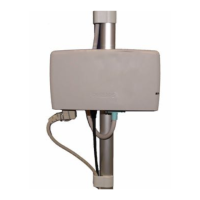171
14
14Monitoring Carbon Dioxide
WARNING •Measurements from an MMS extension connected to an X2 are not available when the X2 is
running on battery power. They are only available when the X2 is running on external power, either
when connected to a host monitor or the external power supply (M8023A).
•Only one CO
2
measurement at a time is supported.
Use the CO
2
measurement to monitor the patient’s respiratory status and to control patient
ventilation.
There are two methods for measuring carbon dioxide in the patient’s airway:
•Mainstream measurement uses a CO
2
sensor attached to an airway adapter directly inserted into the
patient’s breathing system. This method is available using the monitor’s built-in CO
2
measurement
(optional), the M3014A Capnography Extension or the M3016A Mainstream Extension.
•Sidestream measurement takes a sample of the respiratory gas with a constant sample flow from the
patient’s airway and analyzes it with a remote CO
2
sensor. You can measure sidestream CO
2
using
the monitor’s built-in CO
2
measurement (optional) or using the M3014A Capnography Extension,
or the M3015A Microstream CO
2
Extension.
In both cases, the measurement principle is infrared transmission, where the intensity of infrared light
passing the respiratory gas is measured with a photo detector. As some of the infrared light is absorbed
by the CO
2
molecules, the amount of light passing the gas probe depends on the concentration of the
measured CO
2
.
When using a wet ventilator circuit, monitor mainstream CO
2
if available, in preference to sidestream
CO
2
.
The partial pressure is calculated from the gas concentration by multiplying the concentration value
with the ambient pressure.
The measurement provides:
•a CO
2
waveform.
•an end tidal CO
2
(etCO
2
) value: the CO
2
value measured at the end of the expiration phase.
•an inspired minimum CO
2
(imCO
2
): the smallest value measured during inspiration.
•an airway respiration rate (awRR): the number of breaths per minute, calculated from the CO
2
waveform.

